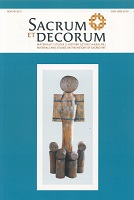Kościół pw. św. Brunona w Giżycku – pierwsza świątynia upamiętniająca niemieckich bohaterów wojennych w Prusach Wschodnich
Saint Bruno’s Church in Giżycko – the first church commemorating German World War I heroes in East Prussia
Author(s): Marek JodkowskiContributor(s): Grażyna Ryba (Editor)
Subject(s): History, Fine Arts / Performing Arts, Theology and Religion
Published by: Wydawnictwo Uniwersytetu Rzeszowskiego
Keywords: German architecture; Diocese of Warmia; Giżycko; Martin Weber; St Bruno; soldiers memorial
Summary/Abstract: The article presents the historical outline and ideological circumstances concerning the construction of Saint Bruno’s Church in Giżycko as well as the novel form (in liturgical context) of the altar design. In the inter-war period (1918–1939) various initiatives were undertaken in Germany to commemorate the soldiers fallen during World War I. A very important role in this respect was played by the German War Graves Commission (Volksbund Deutsche Kriegsgräberfürsorge). Starting from 1922 National Mourning Day was commemorated in the Weimar Republic, which 12 years later was renamed Heldengedenktag (Memory of Heroes Day) and it was declared an official national holiday. In Giżycko, where Catholics were in a diaspora, a decision was taken to build a church which would function as a church-cum-monument to the fallen soldiers, the first of its kind in East Prussia. The initiator of the plan to erect the church was Father Severin Quint whereas Martin Weber was responsible for the architectural design of the building. The blessing of the cornerstone took place on 23 August 1936 and the church was opened on 8 August 1937. On 23 August 1938 the church was adorned with decorations. This modern place of worship, which also performed the function of a garrison church, was full of military references and military symbolism. The middle section of the facade was decorated with a sgraffito image of Saint Bruno of Querfurt accompanied by a Teutonic Knight on one side and a contemporary German soldier on the other. This figurative image was supposed to symbolise the heroic conduct of the German army, rooted in history and supported by the blessings of the Apostle of the Prussians. As far as the interior is concerned, the positioning of the altar enabling the priest to celebrate the mass versus populum was a truly novel solution on the territory of the Warmia Diocese at the time and, in a way, heralded the changes in Catholic liturgy which were to take place some years later after the Second Vatican Council.
Journal: Sacrum et Decorum. Materiały i studia z historii sztuki sakralnej
- Issue Year: 2015
- Issue No: 8
- Page Range: 35-49
- Page Count: 15
- Language: English, Polish

